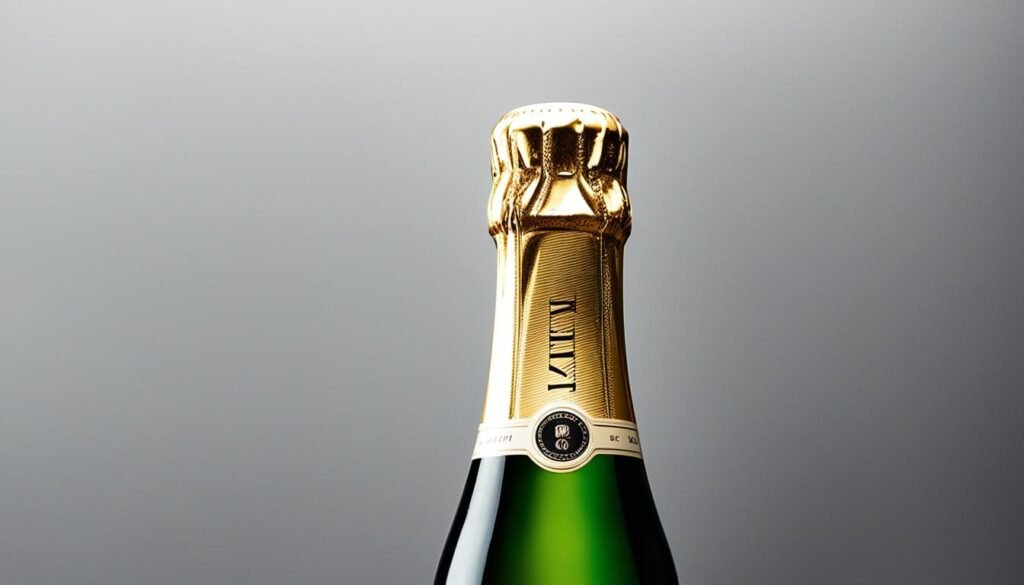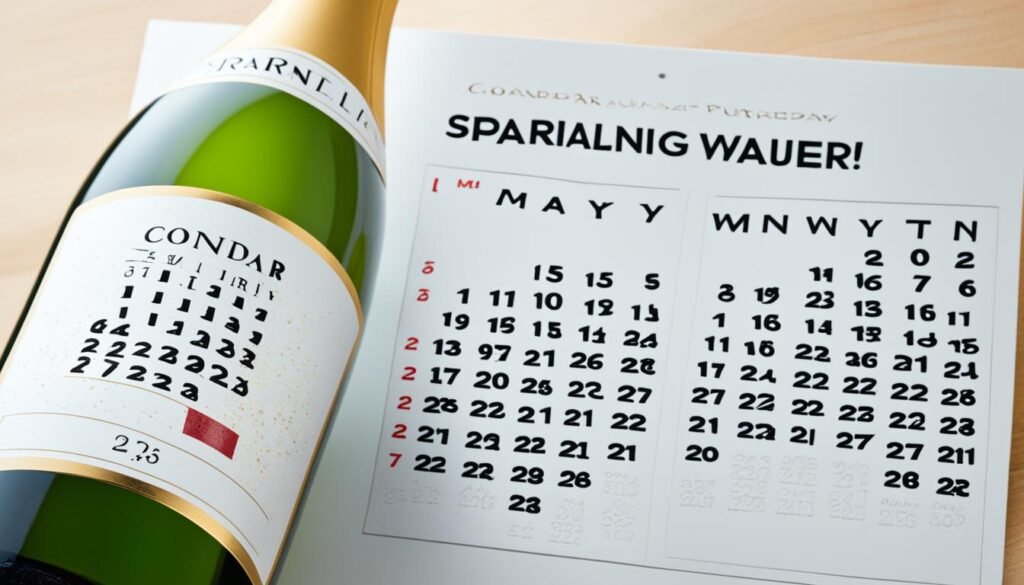“Wine is constant proof that God loves us and loves to see us happy.” – Benjamin Franklin. This quote beautifully encapsulates the joy that a good bottle of sparkling wine can bring to our celebrations. However, one question that often arises is, how long does sparkling wine last? Understanding the sparkling wine shelf life is essential for any wine enthusiast, enabling us to enjoy each effervescent sip at its best.
In this guide, I’ll explore the intricacies of sparkling wine longevity, whether opened or unopened. Numerous factors, from the quality of the wine to proper storage techniques, play a crucial role in preserving sparkling wine freshness. Join me as we uncover how to best enjoy this delightful treat throughout its lifespan.
Understanding Sparkling Wine Shelf Life
When I ponder the shelf life of sparkling wine, I recognize several critical factors. The quality of the sparkling wine is a major determinant of its longevity. Typically, most sparkling wines should be consumed within 1 to 5 years. However, premium varieties, such as Champagne, can last a decade or more if stored correctly.
Proper storage conditions are crucial for maintaining the freshness and flavor of sparkling wine. It’s advised to store sparkling wine at a consistent temperature, ideally between 45°F and 65°F (7°C to 18°C). Fluctuations in temperature can cause the wine to age prematurely. Moreover, exposure to light can diminish the quality of the wine, so it’s best to keep it in a dark or dimly lit area.
Ensuring the quality of sparkling wine relies on understanding its shelf life and adhering to optimal storage conditions. By considering these factors, I can greatly improve my enjoyment of these exquisite beverages.
How Long Does Sparkling Wine Last Opened?
For those who cherish sparkling wine, it’s crucial to grasp the time frame it remains fresh after opening. The quality of the wine declines as time passes post-opening. I aim to detail the ideal time frame and strategies for maintaining its freshness.
Optimal Duration After Opening
Typically, sparkling wine stays at its peak for 3 to 4 days once opened. Premium brands like Moët & Chandon and Veuve Clicquot are best savored on the same day. The carbonation swiftly decreases, altering the taste significantly. Keeping abreast of the wine’s longevity can prevent the disappointment of drinking flat wine.
Best Practices for Enjoying Opened Sparkling Wine
Here are some effective methods to preserve the wine’s freshness:
- Employ a sparkling wine stopper to seal the bottle tightly, preserving the bubbles.
- Store the opened bottle in the refrigerator, maintaining a temperature of 45-50°F.
- Steer clear of exposing the wine to room temperature, as it accelerates the loss of carbonation.
How Long Does Sparkling Wine Last Unopened?
The shelf life of unopened sparkling wine varies significantly, influenced by several key factors. It’s crucial to understand these factors to preserve the wine’s taste and quality. While many sparkling wines can last one to three years, this timeframe can be extended or shortened by various elements.
Factors Affecting Unopened Sparkling Wine Longevity
When considering the longevity of unopened sparkling wine, several factors are paramount. These include:
- Type of Wine: Different styles, like Champagne or Prosecco, have distinct lifespans.
- Storage Conditions: Keeping the wine in a cool, dark place greatly enhances its shelf life.
- Closure Type: The cork’s type can influence air exposure and the wine’s freshness.
Quality and Type of Sparkling Wine
The quality of sparkling wine is a major factor in its longevity. High-quality wines, made using traditional methods, tend to last longer than more affordable options. For instance, while standard Prosecco may only last a couple of years, exceptional vintage Champagne can endure for a decade or more. I often consult this guide on wine longevity to get the best out of my sparkling wine collection.
In conclusion, understanding these factors not only aids in proper storage but also ensures I enjoy the delightful flavors each bottle offers. The longevity of sparkling wine is a result of its quality and the care in maintaining optimal storage conditions.
Storing Sparkling Wine: Key Considerations
Mastering the art of storing sparkling wine is essential for retaining its flavors and fizz. Exploring the optimal storage conditions reveals several key factors. These elements significantly influence the wine’s longevity.
Conditions for Proper Storage
For maintaining the wine’s taste, it’s crucial to store it in a cool, dark spot. Light and temperature changes should be kept to a minimum. The ideal temperature range is between 45°F and 55°F. A stable environment also helps keep the wine fresh.
Temperature and Humidity Control
Temperature and humidity are crucial for effective sparkling wine storage. Humidity should be between 55% and 85% to prevent the cork from drying out, which can cause oxidation. I’ve found that laying bottles horizontally keeps the cork moist, ensuring a secure seal. Below is a table summarizing the ideal conditions for storing sparkling wine, which I refer to regularly:
| Factor | Ideal Condition |
|---|---|
| Temperature | 45°F – 55°F |
| Humidity | 55% – 85% |
| Light Exposure | Avoid Direct Light |
| Bottle Position | Horizontally |
Following these conditions for proper storage ensures sparkling wine is enjoyed at its peak. Understanding the impact of temperature and humidity on wine quality enhances the drinking experience. For more on pairing sparkling wine with meals, check out this resource.

Preserving Sparkling Wine Freshness
Understanding how to store opened bottles is crucial for maintaining the delightful taste of sparkling wine. One effective method is refrigerating the bottle and using a wine stopper. This approach helps preserve the carbonation, essential for a great tasting experience.
How to Store Opened Bottles
After opening a bottle of sparkling wine, I follow a few key steps:
- Immediately replace the cork with a proper wine stopper.
- Store the bottle upright in the refrigerator.
- Consume the wine within three days for optimal taste.
These steps help extend the life of opened sparkling wine, ensuring I can enjoy it over several days without losing flavor.
Best Way to Store Champagne
Storing champagne at a consistent, cool temperature is vital. I aim for a range of 45°F to 50°F. Additionally, I make sure to drink the oldest bottle first when I have multiple open. This approach keeps my champagne fresh and enhances the tasting experience. For more on choosing the right champagne, see this comprehensive guide.
Following these storage tips ensures sparkling wine remains enjoyable, even on the second or third day after opening.
| Storage Method | Effectiveness | Timeframe for Best Taste |
|---|---|---|
| Refrigerate with Wine Stopper | High | Up to 3 days |
| Cool, Dark Place for Unopened Champagne | Very High | Varies by type |
| Rotating Opened Bottles | Medium | Ensure oldest first |
Does Sparkling Wine Expire?
Understanding whether sparkling wine expires is crucial for enjoying its delightful taste at its best. Indeed, sparkling wine does expire, and recognizing signs of spoilage can prevent unpleasant experiences. If you notice specific indicators, it’s wise to address them promptly.
Common Signs of Spoilage
When assessing the quality of sparkling wine, be on the lookout for the following signs of spoilage:
- A flat appearance or lack of bubbles
- Unpleasant or vinegary odors
- An odd burnt smell
- Off flavors that differ from what you expect
If any of these signs present themselves, it’s worth considering whether the wine has gone bad.
When to Discard Your Sparkling Wine
It is essential to know when to discard sparkling wine to avoid disappointment. If your sparkling wine smells burnt or vinegary and has lost its effervescence, I recommend discarding it immediately. Enjoying sparkling wine soon after purchase typically mitigates the risks associated with spoilage.

Champagne Preservation Tips
To savor the delightful flavors of Champagne beyond its opening, I adhere to a set of crucial preservation tips. The right storage methods are vital for keeping the taste and fizz of this celebratory drink intact. A primary method I employ is the use of quality wine stoppers, which seal the bottle tightly and reduce air exposure.
Using Wine Stoppers Effectively
Wine stoppers are a pivotal tool for keeping opened bottles of Champagne fresh. They form a secure seal, thereby minimizing the loss of carbonation. To achieve the best results, I make sure the stopper fits perfectly. I’ve found silicone or Champagne stoppers to be particularly effective, as they preserve the bubbles and are easy to remove.
Understanding Carbonation Loss
Exposure to air causes carbonation loss in Champagne, resulting in a flat taste. I’ve discovered that temperature is crucial in this process. Warmer temperatures accelerate this loss, so I store opened Champagne in the refrigerator. Keeping it at a consistent cool temperature helps maintain the drink’s sparkle and quality.
For further advice on storing both opened and unopened bottles, I consult resources like this link. It offers valuable insights on preserving the freshness and life of Champagne. These practices ensure I can fully enjoy each glass.
Conclusion
The shelf life of sparkling wine is complex, influenced by quality, type, and storage conditions. Knowing how long sparkling wine lasts, whether opened or sealed, helps me plan better. Adopting best practices for storage enhances the drinking experience, ensuring I enjoy each bubble at its peak.
Learning about proper storage and recognizing spoilage signs is crucial. Keeping in mind the optimal conditions and timeframes for my sparkling wine increases the likelihood of enjoying it as intended. This knowledge is invaluable, whether celebrating a special event or enjoying a casual evening, making the sparkling wine experience better.
Understanding the intricacies of sparkling wine shelf life informs my choices and deepens my appreciation for this effervescent delight. With this knowledge, I can make informed decisions, ensuring every glass is filled with joy and flavor.